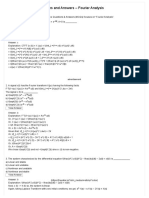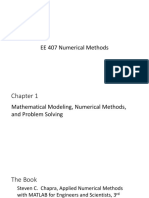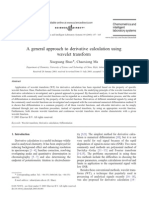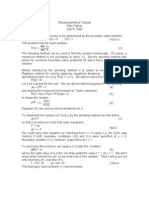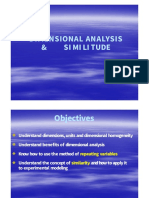Laplace Transforms With MATLAB
Uploaded by
João Gabriel LimaLaplace Transforms With MATLAB
Uploaded by
João Gabriel LimaLaplace Transforms with MATLAB
a. Calculate the Laplace Transform using Matlab Calculating the Laplace F(s) transform of a function f(t) is quite simple in Matlab. First you need to specify that the variable t and s are symbolic ones. This is done with the command >> syms t s Next you define the function f(t). The actual command to calculate the transform is >> F=laplace(f,t,s) To make the expression more readable one can use the commands, simplify and pretty. here is an example for the function f(t),
f (t ) = 1.25 + 3.5te 2t + 1.25e 2t
>> syms t s >> f=-1.25+3.5*t*exp(-2*t)+1.25*exp(-2*t); >> F=laplace(f,t,s) F = -5/4/s+7/2/(s+2)^2+5/4/(s+2) >> simplify(F) ans = (s-5)/s/(s+2)^2 >> pretty(ans) s - 5 ---------2 s (s + 2)
which corresponds to F(s),
F ( s) =
( s 5) s ( s + 2) 2
Alternatively, one can write the function f(t) directly as part of the laplace command: >>F2=laplace(-1.25+3.5*t*exp(-2*t)+1.25*exp(-2*t))
ESE216
b. Inverse Laplace Transform The command one uses now is ilaplace. One also needs to define the symbols t and s. Lets calculate the inverse of the previous function F(s),
F ( s) =
( s 5) s ( s + 2) 2
>> syms t s >> F=(s-5)/(s*(s+2)^2); >> ilaplace(F) ans = -5/4+(7/2*t+5/4)*exp(-2*t) >> simplify(ans) ans = -5/4+7/2*t*exp(-2*t)+5/4*exp(-2*t) >> pretty(ans) - 5/4 + 7/2 t exp(-2 t) + 5/4 exp(-2 t)
Which corresponds to f(t)
f (t ) = 1.25 + 3.5te 2t + 1.25e 2t Alternatively one can write
>> ilaplace((s-5)/(s*(s+2)^2))
Here is another example.
F (s) =
10( s + 2) s ( s 2 + 4s + 5)
>> F=10*(s+2)/(s*(s^2+4*s+5)); >> ilaplace(F) ans = -4*exp(-2*t)*cos(t)+2*exp(-2*t)*sin(t)+4
Which gives f(t), f (t ) = [4 4e 2t cos(t ) + 2e 2t sin(t )]u (t ) making use of the trigonometric relationship, x sin( ) + y cos( ) = R sin( + )
and x cos( ) y sin( ) = R cos( + ) with R = x2 + y2
= tan 1 ( y / x)
One can also write that f(t) = [4 + 4.47e 2t cos(t 153.4o )]u (t )
ESE216 2
Matlab often gives the inverse Laplace Transform in terms of sinhx and coshx. Using the following definition one can rewrite the hyperbolic expression as a function of exponentials:
ex + ex sinh( x) = 2 x e ex cosh(s ) = 2
Also, you may find the Heaviside(t) function which corresponds to the unit step function u(t): thus the function H(t) = heaviside(t) =0 for t<0 and H(t) = heaviside(t)=1 for t>0. As an example, suppose that Matlab gives you the following result for the inverse Laplace transform:
2 heaviside(t-10) exp(-5/2t+25) sinh(1/2t-5)
This can be re-written, using the definition of the sinh(x) function:
2u(t)
f (t ) = 2u (t 10).e 2.5( t 10 ) [ = u (t 10)[e 2t + 20
e 0.5t 5 e 2.5t +5 ] = u (t 10).e 2.5t + 25+0.5t 5 e 2.5t + 250.5t +5 2 3t + 30 e ]
= [e 2 ( t 10 ) e 3( t 10 ) ]u (t 10)
This last expression is closer to what your hand calculations will give you for the invers Laplace Transform.
ESE216
You might also like
- Introduction To Partial Differential Equations With Matlab0% (1)Introduction To Partial Differential Equations With Matlab6 pages
- Chebyshev Collocation Method For Differential EquationsNo ratings yetChebyshev Collocation Method For Differential Equations12 pages
- Lab Report No. 12: Signals & Systems EEE-223No ratings yetLab Report No. 12: Signals & Systems EEE-2236 pages
- Activity 2: Laplace and Inverse Laplace Transform Using MatlabNo ratings yetActivity 2: Laplace and Inverse Laplace Transform Using Matlab4 pages
- Chapter 2 Modeling in The Frequency Domain Skill-Assessment Exercise 2.5No ratings yetChapter 2 Modeling in The Frequency Domain Skill-Assessment Exercise 2.54 pages
- Derivatives, Integrals, Multiplication and Division by T Laplce Transforms by Michael PantonillaNo ratings yetDerivatives, Integrals, Multiplication and Division by T Laplce Transforms by Michael Pantonilla21 pages
- Electromagnetic Fields and Waves HW1 Solution - Iskander100% (1)Electromagnetic Fields and Waves HW1 Solution - Iskander6 pages
- Introduction To Ordinary Differential Equations With: Mathematica®No ratings yetIntroduction To Ordinary Differential Equations With: Mathematica®9 pages
- Unit 3 Fourier Analysis Questions and Answers - Sanfoundry PDF100% (1)Unit 3 Fourier Analysis Questions and Answers - Sanfoundry PDF5 pages
- Systems of Odes. Phase Plane. Qualitative Methods Qualitative MethodsNo ratings yetSystems of Odes. Phase Plane. Qualitative Methods Qualitative Methods26 pages
- A General Approach To Derivative Calculation Using WaveletNo ratings yetA General Approach To Derivative Calculation Using Wavelet9 pages
- Optimal Control of Switching Times in Switched Dynamical SystemsNo ratings yetOptimal Control of Switching Times in Switched Dynamical Systems6 pages
- Addison Wesley - Modern Control Systems Analysis and Design Using Matlab PDFNo ratings yetAddison Wesley - Modern Control Systems Analysis and Design Using Matlab PDF84 pages
- Applications of Laplace Transform Unit Step Functions and Dirac Delta FunctionsNo ratings yetApplications of Laplace Transform Unit Step Functions and Dirac Delta Functions8 pages
- Lab - Introduction To Finite Element Methods and Matlab'S Pdetoolbox100% (1)Lab - Introduction To Finite Element Methods and Matlab'S Pdetoolbox15 pages
- Numerical Methods for Engineers 7th Edition Chapra Solutions Manual - Instant Download To Read The Complete ContentNo ratings yetNumerical Methods for Engineers 7th Edition Chapra Solutions Manual - Instant Download To Read The Complete Content46 pages
- Experiment 5 - Laplace and Inverse Laplace TransformNo ratings yetExperiment 5 - Laplace and Inverse Laplace Transform18 pages






























